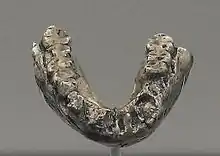LH 4
LH 4 or Laetoli Hominid 4[1] is the catalogue number of a fossilized mandible which was discovered by Mary Leakey in 1974 from Laetoli, Tanzania.[2]
 | |
| Catalog no. | LH 4 |
|---|---|
| Common name | Laetoli Hominid 4 |
| Species | Australopithecus afarensis |
| Age | 2.9–3.9 million years |
| Place discovered | Laetoli, Tanzania |
| Date discovered | 1974 |
| Discovered by | Mary Leakey |
Mary Leakey and her team, Johanson and White,[3] found between 1974 and 1977 forty-two hominid teeth associated with a jawbone. One of them was LH-4, a fine specimen with nine teeth. White described the fossils, and LH-4 was assigned as the "name-bearer" of the new species.[3]
Observations
The specimen is 2.9–3.9 million years old and is mandible of an adult Australopithecus afarensis with all molars present and a fairly large canine.[4][5] Most anterior teeth and rami are missing. But, the dental arcade is in a good condition with little or no evidence of distortion.[2]
References
- "Lateoli". ntz.info. Retrieved 15 October 2012.
- "LH 4". eFossils. Retrieved 15 October 2012.
- Meredith, Martin (18 August 2011). Born in Africa: The Quest for the Origins of Human Life. Simon and Schuster. p. 288. ISBN 9780857206671.
- Tanner, Nancy Makepeace (31 August 1981). "Evidence on the transition: what can the earliest hominid fossils reveal about the ancestral population and the translation?". On Becoming Human. CUP Archive. p. 180. ISBN 978-0-521-28028-0. Retrieved 16 October 2012.
- Clarke 2012, p. 48.
Bibliography
- Clarke, Ronald J. (2012). "The history of research in human evolution in Africa and what lessons have been learned". Human origin sites and the World Heritage Convention in Africa. UNESCO. p. 254. ISBN 9789230010812.CS1 maint: ref=harv (link)
External links
| Wikimedia Commons has media related to LH 4. |
This article is issued from Wikipedia. The text is licensed under Creative Commons - Attribution - Sharealike. Additional terms may apply for the media files.